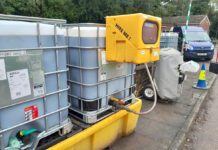Dr Chris Charles of Genesis Biosciences discusses the use of biological products for this purpose
It’s no surprise that a facility dealing with wastewater generated by a local population will have a distinct odour. Complex organic materials from a multitude of sources combine to produce an array of malodours, from rotting eggs and cabbage to eye-stinging ammonia, but rest assured there are solutions to combat the pong.
There are many different traditional treatments for malodours at a facility including adding chemicals, biological filtration and “capture and treat” technologies which often combine physical coverings or plant with absorption and scrubber systems.
The use of chemicals centres around tackling either septicity or modifying pH to combat odours related to sulphides. Common techniques include the use of nitrate salts or ferric, and aeration. But great care should be taken when dosing such chemicals, as under-dosing may prove ineffective and over-dosing may cause problems further downstream.
The implementation of capture and treat technologies can treat malodour via a few different mechanisms. By employing covers, a plant can prevent gaseous malodours from escaping, and the malodours can then be removed via passage through chemical scrubbers for absorption into a liquid medium or through absorption systems for immobilisation onto a solid support such as activated carbon.
Another method to remove odour is to use biological systems such as a filter or scrubber whereby gas comes into contact with microorganisms and a packing system to encourage degradation of the malodour. Although capable of tackling the issues of odour, these solutions have limited lifespans and can be expensive to establish and maintain. An alternative approach – using biological products – has shown promise in helping to control odour issues.
What are biological products?
Biological products come in either liquid or solid form and generally contain a blend of microorganisms along with preservatives and application specific chemicals. When considering the application of biological products towards odour control, two different methodologies are finding wider use within the industry. These are either through the use of atomisers or mist system techniques or via the direct dosing of bacteria into wastewater systems using an approach known as bioaugmentation. Where, for each of these methods the dominant microbial agents are bacteria of the Bacillus genus, chosen due to their ease of manufacture, low pathogenicity and long-term stability (due to their ability to form spores).
Mist systems typically dose an absorbent agent around the affected area, be it small (a clarifier) or large (lagoon.) The technology works via methods relating to adsorption, whereby the malodour is bound to, or encapsulated by the agent and is either neutralised or masked from the receptors within the nose. The bacteria within these products then act to facilitate the degradation of either captured malodorous compounds or the sources of the compounds. This method is both fast acting and cost effective.
The direct dosing of different microbial species provides an opportunity to expand the metabolic potential of a system as well as impact the growth of sulphate-reducing bacteria through a range of mechanisms. These mechanisms may include the production of antimicrobial secondary metabolites or through direct competition for space and resources.
Further to this, microbes are often combined with a chemical agent such as sodium nitrate or percarbonate to promote either denitrification or aerobic metabolism within anaerobic zones.
The supplementation of additional microbes such as Bacillus aims to use up potential organic substrates capable of facilitating sulphate reduction.
Although becoming more popular, not all bioaugmentation products are equal in performance. When considering dosing bacteria to a system it is important to take into account its residence time.
The key to the activated sludge system is the ability to grow and retain biomass via flocculation and settlement. If a bioaugmentation product contains microbes that do not form biofilm or flocs then it is likely their residence time will be equal to the hydraulic retention time, rather than the longer solids retention time. It is this prolonged residence time that is needed for the additional microbes to acclimate and proliferate in order to make any significant difference within a system.
There are many different wastewater bioaugmentation products available for a range of different problems, however, these products are often poorly defined with little supporting data. Genesis Biosciences recently launched Evogen WWT – a brand-new eco-friendly treatment range for sewage and wastewater plants that has been designed specifically to remedy a broad host of common WWT issues ranging from scale removal to fats, oils and grease remediation to odour control.
The technology has been launched in the UK and Italy and will roll out across Europe and America throughout 2020.







